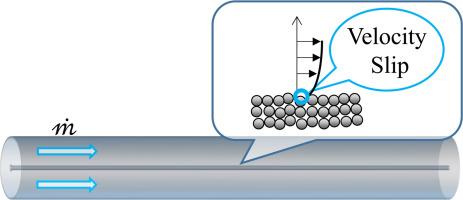稀薄气体流动中细丝表面粘滞滑移系数的测量
IF 5.8
2区 工程技术
Q1 ENGINEERING, MECHANICAL
International Journal of Heat and Mass Transfer
Pub Date : 2025-10-07
DOI:10.1016/j.ijheatmasstransfer.2025.127914
引用次数: 0
摘要
在稀薄气体流动中,速度滑移现象随着克努森数的增加而出现,并对流场产生强烈影响。计算速度滑移的大小是很重要的。在这项研究中,提出了一种新的方法来测量细导线表面的粘性滑移系数,该系数表示高努森数流动中速度滑移的大小。制备了一种同轴圆柱形状的微通道,该微通道由一根细导线置于圆形微管的中心轴线上。然后,用等体积法测量细丝与微管间隙的质量流量。然后将测量结果与微管中没有细丝的情况下的测量结果进行比较,并通过将分析质量流量与测量值拟合,推导出细丝上的粘滞滑移系数。我们在玻璃微管中使用铂细丝进行测量,成功地获得了铂表面氦和氩的粘性滑移系数。从粘滞滑移系数出发,计算了切向动量调节系数。我们的新方法使得测量金属表面的速度滑移成为可能,从而在更广泛的样品表面上进一步积累数据。本文章由计算机程序翻译,如有差异,请以英文原文为准。

Measurement of viscous slip coefficient on a thin wire surface in rarefied gas flows
In rarefied gas flows, velocity slip phenomenon appears with increasing Knudsen number and has a strong influence on the flow field. It is important to evaluate the size of velocity slip. In this study, a novel approach was proposed to measure the viscous slip coefficient, which represents the magnitude of velocity slip in high Knudsen number flows, on the surface of a thin wire. A microchannel with coaxial-cylinders geometry consisting of a thin wire placed on the center axis of a circular microtube was prepared. Then, the mass flow rate through a gap between the thin wire and the microtube was measured using the constant-volume method. The measured results were subsequently compared with those obtained with the microtube only, i.e., without the thin wire, and the viscous slip coefficient on the thin wire was deduced by fitting the analytical mass flow rates to the measured values. From our measurements using a platinum thin wire inside a glass microtube, the viscous slip coefficients for helium and argon on the platinum surface were successfully obtained. From the viscous slip coefficients, the tangential momentum accommodation coefficients were also calculated. Our novel approach makes it possible to measure the velocity slip on metal surfaces, leading to further accumulation of the data on a wider variety of sample surfaces.
求助全文
通过发布文献求助,成功后即可免费获取论文全文。
去求助
来源期刊
CiteScore
10.30
自引率
13.50%
发文量
1319
审稿时长
41 days
期刊介绍:
International Journal of Heat and Mass Transfer is the vehicle for the exchange of basic ideas in heat and mass transfer between research workers and engineers throughout the world. It focuses on both analytical and experimental research, with an emphasis on contributions which increase the basic understanding of transfer processes and their application to engineering problems.
Topics include:
-New methods of measuring and/or correlating transport-property data
-Energy engineering
-Environmental applications of heat and/or mass transfer

 求助内容:
求助内容: 应助结果提醒方式:
应助结果提醒方式:


